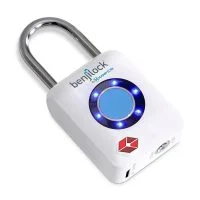
BenjiLock TSA is a Fingerprint TSA Travel Lock (Travel Sentry® Approved).
Yes. This current version of BenjiLock is TSA approved. The patented technology of BenjiLock is the first of its kind accepted by the TSA (Transportation Security Administration) , so if the users’ luggage has to be opened by security, it can then be returned by keeping its valuables safe and secured during its trip. We are living in an instant gratification world and need everything now, easy and convenient. The BenjiLock by Hampton Fingerprint Travel Lock is all of that and more.
BenjiLock TSA is ideal to use while traveling for work or for your dream vacation! However, you’re more than welcome to use it at the gym, school, college or workplace.
Your BenjiLock TSA can store up to 5 multiple users.
Your BenjiLock TSA does not provide keys. Only the TSA (Transportation Security Administration) can open this lock.
BenjiLock TSA was not designed to be used in an outdoor environment (typical adverse weather conditions such as heavy rain, ice, snow, fog, and dust). However, if your BenjiLock TSA gets wet, it will and still should work. This version of BenjiLock is primarily targeted towards personal luggage, gym bags, backpacks, and your daily locker of preference.
No. You do not need a computer or a smartphone to setup your device.
No. You do not need a Wi-Fi connection to setup your BenjiLock.
Very easy! Follow these simple steps and you’ll be ready to go!
Close the shackle and you’re ready to go!
Very easy! Follow these simple steps and you’ll be ready to go!
Close the shackle and you have now changed your passcode on your BenjiLock TSA.
Very easy! Follow these simple steps and you’ll be ready to go!
Close the shackle and you have now added a user to your BenjiLock TSA.
Close the shackle and your BenjiLock TSA is now reset.
Based on the amount of usage per day, your BenjiLock TSA can last 6 months to a year on a single charge.
Your BenjiLock TSA includes a fully built-in rechargeable lithium-ion battery and comes partially charged. However, on an empty level, it could take a maximum of 3 hours for a battery to fully recharge.
Your BenjiLock TSA comes partially charged, however, it is recommended to fully charge your lock with the included Micro USB cable.
Your BenjiLock TSA will show red if it’s in need of more charge and blue when it’s fully charged.
When your BenjiLock TSA is in programming mode, the blue lights will rotate on the front in a wheel pattern.
No. BenjiLock TSA does not operate through Bluetooth and does not require a mobile application or an app for functionality.
Yes, your BenjiLock TSA is approved by the Travel Sentry program which currently covers 30 countries all over the world. However, not all the security officers outside the U.S have the same TSA master keys, so even a TSA-approved lock could be cut off if you are traveling internationally.
TSA may inspect your checked baggage during the screening process. If they do, their standard practice is to leave a “Notice of Baggage Inspection” informing you that your bag was inspected.
We got you covered! If you’re luggage or bag has a “Notice of Baggage Inspection” by the TSA and your BenjiLock TSA is missing, please, contact us by submitting a ticket or reach our toll free-number 1.833.252.3654 Monday through Friday 8:30 AM to 5:00 PM PT to replace your unit under these circumstances.
A2. Except for spare (uninstalled) lithium metal and lithium-ion batteries, all the batteries allowed in carry-on baggage are also allowed in checked baggage. The batteries must be protected from damage and short circuit or installed in a device. Battery-powered devices—particularly those with moving parts or those that could heat up—must be protected from accidental activation. Spare lithium metal and lithium-ion/polymer batteries are prohibited in checked baggage—this includes external battery packs. Electronic cigarettes and vaporizers are also prohibited in checked baggage. “Checked baggage” includes bags checked at the gate or planeside.
For more information in regards to your checked baggage (including gate-checked bags), you’re more than welcome to visit the FAA’s website.
A1. For carry-on baggage checked at the gate or planeside, see Q2, below. Passengers can carry most consumer-type batteries and portable battery-powered electronic devices for their own personal use in carry-on baggage. Spare batteries must be protected from damage and short circuit. Battery-powered devices must be protected from accidental activation and heat generation. Damaged or recalled batteries, including when in a device, must not be carried. Batteries allowed in carry-on baggage include:
With airline approval, devices can contain larger lithium-ion batteries (101-160 watt-hours per battery), but spares of this size are limited to two batteries in carry-on baggage only. This size covers the largest aftermarket extended-life laptop batteries and most lithium-ion batteries for professional-grade audio/visual equipment.
For more information in regards to your carry-on baggage (in the aircraft cabin), you’re more than welcome to visit the FAA’s website. For more information, support and warranty, please visit BenjiLock.care.
You’re more than welcome to visit our YouTube channel to learn how to setup your BenjiLock, visit our support site or reach our toll free-number 1.833.25BENJI Monday through Friday 8:00 AM to 5:30 PM PT.
Save time by starting your support request online.

Copyright © 2023 BenjiLock, LLC. All rights reserved.